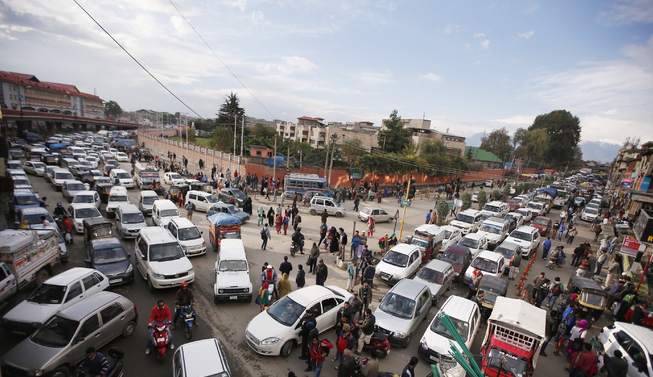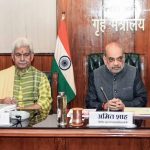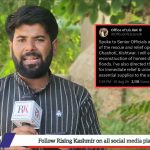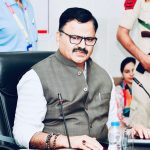Over the years, traffic congestion has become an exasperating reality for the people and visitors of the Kashmir Valley. The picturesque landscapes are marred by the incessant honking of vehicles and the frustration of gridlocked roads. The immediate trends indicate that traffic woes will continue to get worse in the near future posing a serious and worsening problem. Till now the traffic department has not done enough to chalk out a comprehensive policy as how to negotiate with the growing traffic and how it can be streamlined. The rising incidents of road accidents portray a grim picture and give an indication as how ruthlessly the traffic laws and regulations are being violated across the Valley.
Traffic department should create a certain degree of caution in the minds of traffic violators. If we have to develop a hassle free traffic mechanism, a sustainable and effective strategy is needed to cope up with the future traffic challenges. There is a dire need to restructure the traffic mechanism and to relieve the people from the daily torment which they have to undergo due to heavy traffic jams and disruptions. The traffic department needs to act wisely and judiciously. Building more flyovers and underpasses for smooth flow of traffic has become inevitable in order to reduce traffic congestion on roads. The lane management is also crucial. At the same time, the commuters must also abide by traffic rules and avoid changing of lanes too frequently. Even if authorities come up with better plans, road diversions, controlled traffic systems, it eventually comes down to people driving in the city.
Some strategies to restore the serenity and efficiency of our transportation network:
Infrastructure Development
At the heart of the traffic woes is the inadequate infrastructure. Expanding and modernizing the existing road network is imperative. This includes constructing bypasses, flyovers, and ring roads to divert traffic from congested city centers. Improved road conditions and better maintenance can also reduce bottlenecks caused by unexpected road closures and repairs.
Public Transportation Enhancement
Encouraging the use of public transportation can significantly alleviate traffic congestion. The introduction of a reliable, frequent, and affordable public transport system, including buses and light rail, could provide a viable alternative to private vehicles. Additionally, incentivizing the use of public transport through subsidized fares and improved facilities at bus and rail stations can further reduce the dependency on personal cars.
Promotion of Non-Motorized Transport
Non-motorized transport, such as cycling and walking, should be promoted. Developing dedicated cycling lanes and pedestrian pathways can encourage people to choose healthier and more sustainable modes of transport, particularly for short distances. This would not only reduce traffic but also contribute to a reduction in air pollution and improvement in public health.
Traffic Management and Smart Technologies
Implementing advanced traffic management systems can optimize the flow of vehicles. Smart traffic signals that adjust based on real-time traffic conditions, along with better enforcement of traffic laws, can prevent unnecessary jams and accidents. The use of technology, such as GPS-based navigation systems that provide real-time traffic updates, can help drivers choose less congested routes.
Parking Solutions
Parking is a significant contributor to traffic congestion, with vehicles often occupying road space or drivers circling in search of spots. Constructing multi-level parking facilities and enforcing strict parking regulations can free up valuable road space. Additionally, implementing a park-and-ride system can encourage commuters to park their vehicles on the outskirts and use public transport to reach the city center.
Policy and Governance
Strong governance and effective policies are crucial. Urban planning should prioritize traffic management, and policies that discourage the excessive use of private vehicles, such as congestion charges or higher registration fees, can be effective. Collaboration between local governments, urban planners, and the community is essential to develop and implement sustainable solutions.
Public Awareness and Behavioral Change
Educating the public about the benefits of alternative transport options and responsible driving behavior is crucial. Campaigns that promote carpooling, respect for traffic rules, and the advantages of public and non-motorized transport can foster a culture of considerate and sustainable travel.
In conclusion, easing the traffic jams in Kashmir Valley requires a comprehensive and coordinated approach. To begin with, the government can hire experts to devise multi-pronged policy to streamline the traffic. Unless the government gives serious thought to the issue, it is not going to be resolved by piecemeal measures like diversions. It is anybody’s guess as to how worse the traffic scenario will get unless some comprehensive plan is formulated and is implemented on war-footing basis. This is not just a matter of convenience but a necessity for the economic, environmental, and social well-being of the valley.
(Author is Asst Professor in public administration working in Bangalore)









